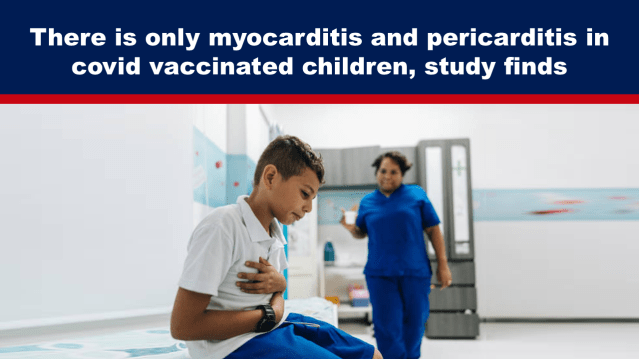There is only myocarditis and pericarditis in covid vaccinated children, study finds
A study involving 1.7 million children in England aged between 5 and 15 years old has found that myocarditis and pericarditis only developed in children who had received Pfizer’s covid injections. Not a single unvaccinated child in the group suffered from these heart conditions.
Let’s not lose touch…Your Government and Big Tech are actively trying to censor the information reported by The Exposé to serve their own needs. Subscribe now to make sure you receive the latest uncensored news in your inbox…
A study was published in May 2024 by the Bennet Institute for Applied Data Science, a multidisciplinary team based at the University of Oxford. It was an observational study to assess the safety and effectiveness of the first and second doses of Pfizer-BioNTech’s (BNT162b2) covid injection in children and adolescents in England. The injection was offered to this age group from September 2021 as part of the Government’s national covid injection campaign.
The study used the OpenSAFELY-TPP database and included adolescents aged 12-15 years and children aged 5-11 years, comparing unvaccinated and single-vaccinated children with those receiving a second dose.
It compared data for at least 1,678,668 children and adolescents comprising:
- 820,926 unvaccinated adolescents.
- 441,858 adolescents who had received a first dose.
- 283,422 unvaccinated children.
- 132,462 children who had received a first dose
- There is no indication of how many adolescents and children who had received a second dose were included in the study.
The study used the incidence rate ratio (“IRR”), separately for children and adolescents, to compare unvaccinated outcomes to vaccinated outcomes and the first does (single-vaccinated) to those who had two doses of Pfizer’s “vaccine.”
IRR measures the relative difference in incidence rates between two groups. An IRR greater than 1 indicates a higher incidence rate in one group compared to the other group. An IRR less than 1 indicates a lower incidence rate in one group compared to the other group. An IRR of 1 indicates no significant difference in incidence rates between the two groups.
For example, suppose a study examines the relationship between cigarette smoking and lung cancer. Say the IRR is calculated as 9.6 for people who smoked for <5 years compared to non-smokers. This would mean that people who smoked for <5 years had a 9.6 times higher incidence rate of lung cancer than non-smokers.
The study used a positive SARS-CoV-2 test (for adolescents only), covid-related A&E attendance, covid-related hospitalisation, covid-related critical care admission and covid-related death as outcomes to measure the effectiveness of the “vaccines.” Non-covid-related deaths and fractures were used as negative control outcomes.
Accident and emergency (“A&E”) attendance, unplanned hospitalisation, pericarditis and myocarditis were used as a measurement of the injection’s safety.
The study found that among 820,926 previously unvaccinated adolescents, the IRR for positive covid tests was 0.74 compared to vaccinated adolescents. In other words, there was a lower incidence of covid (by positive test) in unvaccinated adolescents.
The IRRs for the other effectiveness measurements (covid-related A&E and hospitalisation) ranged from 0.58 to 0.99 in unvaccinated adolescents compared to vaccinated adolescents. The negative control, fractures, was 0.89. The IRRs for safety were 0.89 for A&E attendances and 0.88 for unplanned hospitalisation. In other words, in all the measurements for both safety and effectiveness, unvaccinated adolescents were better off than their vaccinated counterparts.
Among 441,858 adolescents who had received a first vaccination, the IRRs comparing a second dose with a first dose only were 0.67 for positive SARS-CoV-2 tests and other effectiveness measurements ranged from 0.60 to 1.00. The negative control, fractures, was 0.94. The IRRs for safety were 0.93 for A&E attendance and 0.99 for unplanned hospitalisation. Again, there were fewer incidents of covid-related issues in those who only had one dose, although some of the IRRs are close to 1 suggesting that for some measurements the outcomes were the same after the first dose and the second.
Fortunately, it seems most of these potentially serious conditions developed after the second dose did not result in critical care admissions. “Fewer than seven (exact number redacted) covid-19-related critical care admissions occurred in the adolescent first dose vs unvaccinated cohort,” the study authors said. The study does not mention how many adolescents ended up in critical care after the first dose. From the other IRRs, none of which related to critical care admissions, we could deduce a similar number – less than seven.
The study included 283,422 unvaccinated children and 132,462 children who had received a first vaccine dose. It found that covid-related outcomes used to measure effectiveness were too rare to estimate IRRs precisely in children. In other words, covid-related A&E attendance, covid-related hospitalisation, covid-related critical care admission and covid-related death for children (aged 5-11) were so rare that the authors were unable to assess the effectiveness of the covid “vaccine.”
As many researchers independent of corporate funds have been saying for years, why are children being vaccinated if they are not at risk from covid? And it’s not only children who did not die with covid (i.e. after a positive test); no adolescents died with covid either. As the study noted, “There were no covid-related deaths in any group [neither children nor adolescents].”
Worse still, the authors noted a problem with the safety of Pfizer’s injection for children – there were potentially serious health issues experienced by children after the first dose of Pfizer’s injection. The study authors noted that A&E attendance and unplanned hospitalisation (the study’s measurements of safety) were slightly higher after the first vaccination (versus no vaccination) and slightly lower after the second vaccination (versus a single dose).
The most notable result of the study relates to myocarditis and pericarditis. “Among both adolescents and children, myocarditis and pericarditis were documented only in the vaccinated groups, with rates of 27 and 10 cases/million after first and second doses respectively,” the study said.
You can read the OpenSAFELY study HERE.




